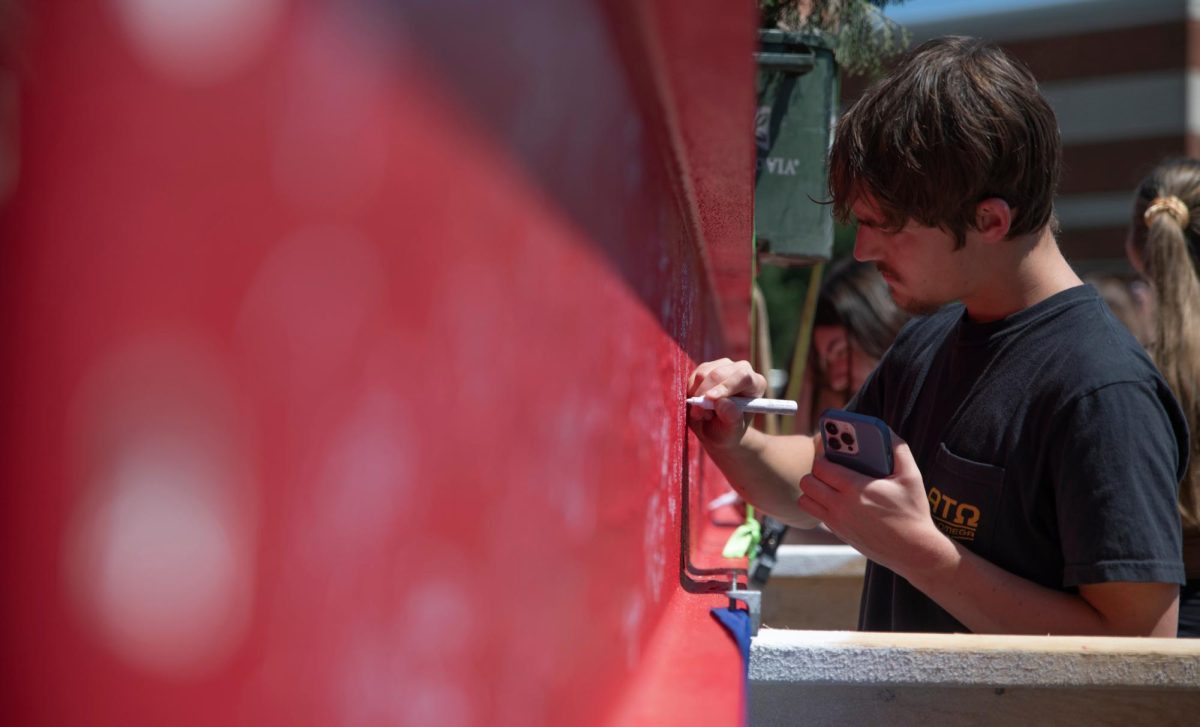Back from the Brink
May 14, 2003
A decade ago, Western’s football program was on the ropes. Only a 5-4 vote by the Board of Regents kept the Toppers on the Hill. But after clinching its seventh straight winning season, the program is thriving, poised for another run at the I-AA playoffs.
A red mesh hat sits behind Jack Harbaugh’s desk.
Its message – “Keep Western Football” – serves as a reminder that his office under Smith Stadium might be a parking space today if not for a single vote.
Looking at the stadium makes it hard to imagine a parking lot in its place. But had the football program not been saved by a narrow Board of Regents vote and massive fund-raising effort, that could be today’s reality.
Ten years ago, Western football was far from the cusp of conference championships. It was within one vote of being knocked down and paved over. Now, the program is within one win of a third straight playoff appearance and possible Gateway Conference championship.
Smith Stadium, in all its one-sided glory, is no longer in danger. But it was.
When faced with an overall budget cut of $6.1 million in 1992, the university searched for ways to save money.
Every academic department could have been affected, but the easiest way to save that much money would be to make one large cut.
Enter football.
With an operating budget of nearly $600,000, some thought it logical to get rid of one football program instead of taking chunks from many academic departments.
Coach Jack Harbaugh remembers a meeting with then-President Thomas Meredith the Friday before spring practice was to begin in March 1992. Meredith recommended they not start spring practice because football would not be played in the fall.
A pair of back-to-back losing campaigns in the previous two seasons made such a proposal easier. Western went a combined 5-16 in 1990 and 1991.
“That was one of the reasons, too,” Harbaugh said. “Drop football when football is not doing well and no one will really care.”
Meredith faced pressure from a petition by the American Association of University Professors, which passed a resolution that semester suggesting Western eliminate football.
The faculty’s main argument was a 1989 Faculty Senate report showing the athletics department, football in particular, had overspent its budget by hundreds of thousands of dollars and once had a $1.5 million deficit.
But Arvin Vos, the Faculty Senate chairman at the time, said cutting football was Meredith’s idea alone.
“What the then-Faculty Senate said was we just needed to cut athletics expenses,” said Vos, still a professor of philosophy and religion. “There was no program on the part of the faculty aimed at football as such.
“We very carefully made our criticism that the athletics budget is out of line with the university budget.”
Repeated attempts to contact Meredith were unsuccessful.
Fans also pressured the former president to put more money in basketball and less in football. In Meredith’s plan called “Western XXI” – a vision of the university in the 21st century – basketball was marked the “flagship” sports program.
Football lobbyists said if the program was cut, Western would still have to pay $600,000 to other schools for games scheduled and existing coaches’ salaries.
And at the time, 80 of the 348 black students on campus were on the football team. Cutting the program would have decreased campus diversity.
Harbaugh looked into cutting scholarships, trimmed the travel budget by pulling out of a move to the Gateway Conference – which Western ultimately joined in 2001 – and offered to cut his salary by $10,000.
An Athletics Task Force was formed to decide the best remedy to save football, while also finding the best possibilities for all sports in the next five years.
In the meantime, the coach went to his team with the possibility football would be lost. He asked them if they wanted to keep practicing.
They did, because the decision wouldn’t come for another month. They wanted to play.
Harbaugh cited other programs, Austin Peay and Tennessee-Martin, which faced similar circumstances and never recovered.
“The reason being, the players didn’t stay loyal,” Harbaugh said. “Here, to the man at that point in time, everybody stayed loyal to the football program. I think that was the most instrumental thing in the entire situation was that our players stayed.”
A budget committee chaired by Meredith had voted that football had to be dropped. A recommendation was made to the Board of Regents, which voted on the proposal on April 30.
The Regents voted 5-4 on a proposal that saved football, but at a cost.
The program would receive only $450,000 from the university budget to operate, but it needed about $345,000 more. The Toppers lost two assistant coaches – remaining one short today – and at least 10 scholarships, Harbaugh said.
“We can’t compete in I-AA football like this,” Harbaugh recalls thinking at the time. “It was like it was going to be a slow death. We lost four coaches, our budget was cut in half, scholarships were lost. They’ve given you football, but they strangled you so eventually you’re going to suffocate.”
And Harbaugh still contends the decision was never about money.
“The thing about finances really wasn’t the driving thing in it,” Harbaugh said. “The driving thing in it was Dr. Meredith had been getting some pressure from the Faculty Senate. That was his carrot. He was going to throw football out of here to try to put himself in good position with the Faculty Senate.”
Whatever the reasoning, the football program still needed to have more money to be competitive in Division I-AA.
So the Hilltopper Athletic Foundation organized a private fund raising effort. There was a goal to make $150,000 in ticket sales.
“When we were told that we possibly would be eliminated, many, many facets of the university and the community got together to raise the money,” then-athletics director Lou Marciani said.
About half the money was brought together by the W-Club, HAF and other alumni. An additional $85,000 came from a road game at Southwest Louisiana.
“The objective was very simple,” Marciani said. “To maintain the great tradition in football. To have the athletes to participate in football was important for us. To maintain that for future generations.”
Former players Butch Gilbert, Mickey Riggs and Jimmy Feix – who also coached the Toppers and for whom the football field is named – were instrumental in rallying support from old players and alumni.
“That’s when we started writing and calling for solicitations,” Feix said. “We tried to drum up ticket sales. All the politicking was great, but probably the single most critical element was Jack Harbaugh did not leave. He didn’t need this program and those headaches … he dug those heels in and did not leave.”
Football had been played on the Hill since 1913, and Harbaugh didn’t want to be the one that let it go.
“I didn’t want football to be dropped at Western Kentucky on my watch,” he said. “It got very personal. Very personal.”
He joined the fight to sustain the program – a fight that was aided by those red mesh hats, which were sold to raise money and spur support for the program.
More than 2,000 people showed up at the Red-White game to show their loyalty. And Western even played a game against a team from Moscow at the end of spring practice to raise money.
“It was a dog and pony show to try to save football at Western Kentucky,” Harbaugh said. “I’m part of this dog and pony show. My entire life is football. I’m here with bells and whistles trying to support it by bringing in all this gimmick stuff.”
Then came what may have been the program’s salvation – a $3.1 million anonymous donation, which at the time was the single largest donation received by the university. It helped return the lost scholarships and keep the Toppers competitive, financially.
But they still had to repair the damage.
Marciani said the word on the street in Kentucky was Western was cutting football, which seriously hurt recruiting.
Harbaugh gave one person credit for helping revitalize a paralyzed recruiting scene. His son Jim volunteered to recruit even though he was a quarterback with the Chicago Bears.
Jim gave his dad a pep talk after seeing him slumped over on his desk in the middle of recruiting season.
“I understand you and I don’t like what I’m seeing,” Jack remembers his son saying. “Look at you. We can do something. We don’t have to sit around feeling sorry for ourselves.”
So Jim went on a recruiting binge to Florida – a hotbed of prep talent – that spanned nearly a month. Jim went door-to-door from Orlando to Tampa to Bradenton, making for 15-hour days.
Jim Harbaugh brought in two of the program’s best former running backs, Rod Smart and DeWayne Gallishaw, from the Sunshine State.
“We were not a Florida recruiting outfit then,” Jack Harbaugh said. “That opened the bottle, and we’re still feeding off that.”
This season, 13 players on the roster hail from Florida.
Feix said Jim even injected a lot of financial support, including new uniforms. But maybe his biggest contribution to the revitalization of Western football came when Jim landed Willie Taggart, one of only three Toppers to have their jersey retired.
Taggart played quarterback from 1995-1998 and helped solidify the Hilltoppers as one of the most prolific rushing offenses in the country. He was the top rushing quarterback in Division I history at the end of his career and still holds 11 Western records for rushing and scoring.
Harbaugh plucked him from his violence-filled neighborhood in Bradenton, Fla. When Taggart arrived, he didn’t know the program had almost been cut two years earlier.
But looking back, the vote to keep football affected Taggart’s entire life. He met his wife, Taneshia, here. He has an 11-month old son, Willie Jr., with her. And he’s in his second season as co-offensive coordinator at Western.
“There’s no telling where Willie Taggart would be now,” Taggart said. “I probably wouldn’t have my wife, wouldn’t keep my son I have now, the records and meeting the great people I met in Bowling Green.”
In Taggart’s first season, 1995, Western finished 2-8. Despite the record, that season was the beginning of the upswing. The Toppers went 7-4 in 1996, and since then, Harbaugh has slowly taken the program to one of the most successful stretches in its history. Western is in the middle of the school’s longest stretch of winning seasons, with seven straight, since 1967-1975.
During the last 11 years, Western is the only I-AA school to rank in the top ten in rushing offense every year.
Since 1995, eight of Harbaugh’s Toppers have signed pro contracts, most recently Joseph Jefferson and Mel Mitchell.
With a new president and athletics director who seem committed to sports, the scenario of a decade ago isn’t likely to repeat itself.
“I think the leaders of this institution are committed to a broad-based intercollegiate athletics department that supports football at the highest I-AA level as possible,” Athletics Director Wood Selig said.
That is evident in the $900,000 resurfacing of Feix field and efforts to build an athletic support facility adjacent to Smith Stadium. But the biggest enhancement may be the expanded $1.5 million operating budget.
Selig also said the department is working on a football enhancement fund which would develop a core of football backers that would donate to the program on an annual basis. That’s similar to the newly formed Lady Topper Enhancement Fund that has raised over $250,000 in four months for women’s basketball.
After all the success, Harbaugh remains humble about his recipe for prosperity.
“Good football players that had outstanding character,” Harbaugh said. “Players who were here for the right reasons. They were here to get an education. They were here to play football. And for the most part, they were interested in doing things right.”
He said the players knew it would take time and money to revive the program.
“They didn’t complain about 14-hour bus rides,” Harbaugh said. “(They would say), ‘This is it, we’re going to hang in here and get it turned around.'”
And they have.
Harbaugh, 63, has three years left on his contract. With one game left in the regular season and 86 wins, he needs 21 to eclipse Feix as the all-time winningest coach in Western history.
“I don’t see us changing,” Taggart said. “Seeing the turnaround we had, whoever comes in here after Coach Harbaugh will have to keep that success going. I think they’ll do whatever it takes to do that, because he took the program at its lowest and turned it around … I think we can be a top 10 team year in year out.”
Bowling Green junior Brian Lowder agrees. Lowder, now Western’s starting strong safety, remembers the controversy being on the news when he was 11. His family has consistently given to HAF to support the program.
He remembers those bad days. But like him, the Toppers have grown out of them.
“It’s kind of like you look back now, and you don’t understand how that was a possibility,” Lowder said. “Former players look at how incredible it is at what we’ve done. It’s only going to go up from here.”
Reach Keith Farner at [email protected].



















![Students cheer for Senator at Large Jaden Marshall after being announced as the Intercultural Student Engagement Center Senator for the 24th Senate on Wednesday, April 17 in the Senate Chamber in DSU. Ive done everything in my power, Ive said it 100 times, to be for the students, Marshall said. So, not only to win, but to hear that reaction for me by the other students is just something that shows people actually care about me [and] really support me.](https://wkuherald.com/wp-content/uploads/2024/04/jadenmarshall-600x422.jpg)





